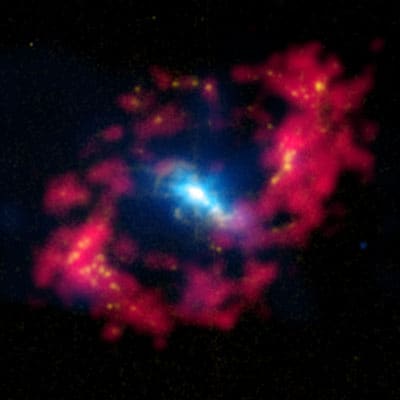
The distance from Earth to the black hole lurking at the centre of a distant galaxy has been determined to unprecedented accuracy by astronomers in Denmark, the UK and Japan. As well as giving us a better estimate of the mass of such black holes, the method could also lead to the creation of a new cosmic distance scale, which could give us accurate and independent measurements of how fast the universe is expanding.
At the centre of most galaxies, including the Milky Way, lies a supermassive black hole that is typically 105–109 times more massive than the Sun. As matter is accelerated into the black hole, lots of radiation is emitted, creating an extremely bright object called an active galactic nucleus (AGN). Such supermassive black holes are of great interest to astronomers because their formation is related to the evolution of their surrounding galaxies.
Flickering lights
Deep within an AGN is a relatively compact accretion disc of material that generates ultraviolet (UV) light as additional matter is accelerated into the black hole. Some of this UV light travels directly to Earth, where it can be detected as a flickering signal. But beyond the accretion disc is a gaseous “broad line region” (BLR) and then a dusty torus – and some of the UV light travels towards the torus, where it stimulates the emission of infrared light in a process called reverberation.
Some of this infrared light will travel to Earth and be detected. So, by measuring the time delay between a flicker of the UV light and the same flicker in the infrared, astronomers can calculate how long it takes light to travel across the BLR. The radius of the BLR can then be calculated by multiplying this time by the speed of light.
As the intensity of light emitted by a black hole increases as the square root of this radius, if two AGNs have the same BLR radius, but different intensities, then the brighter object will be closer to Earth. This concept led Darach Watson and colleagues at the University of Copenhagen and the University of Queensland to propose a new way of measuring cosmological distances in 2011 (see “Active galactic nuclei measure the universe”). The pair measured the disc radii and brightness of about 30 AGNs, but the snag is that the technique can only determine which object is closer, not how far away each is from Earth.
Simple trigonometry
To measure absolute – not relative – distances with the method would require an additional observation using a different technique. Now, however, Watson, together with Sebastian Hönig and colleagues at Copenhagen, Southampton and Kyoto Sangyo universities, have managed to measure the absolute distance using a simple relationship familiar to anyone who has studied trigonometry.
The team used the two telescopes of the Keck Observatory in Hawaii to observe the AGN at the centre of NGC 4151 – a galaxy that lies about 63 million light-years from Earth (or 19 megaparsecs). Light from both telescopes, which are a distance of 85 m apart, is fed to an interferometer, which let the team measure the tiny angle between the light arriving from the centre of the AGN and the light arriving from the outer radius of the BLR.
As the radius of the BLR is already known from a reverberation measurement, the distance to the AGN can be calculated by simply dividing the radius by the angle. Darach and colleagues were able to gauge the distance to the AGN to within an uncertainty of about ±2.5 megaparsecs, which is much better than measurements using other techniques.
In principle, once the absolute distance of one AGN is determined in this way, the absolute distances to other AGNs can be worked out simply using their brightness and BLR radii. “I’m really excited about this result because it couples so beautifully to our previous discovery of a way to measure relative distances with active galaxies,” says Watson.
Independent distance scale
The distance to faraway objects is currently determined using a complicated “cosmic distance ladder” that employs several different techniques that apply only over specific distance ranges. The new AGN technique, in contrast, could be used over a wide range of cosmic distances. As Watson explains, this could “avoid all the mess associated with the cosmic distance ladder”, giving astronomers “an entirely separate and totally independent set of cosmic-distance measurement tools using only active galaxies and nothing else”.
This in turn could yield a new and independent measure of the rate at which the universe is expanding, and ultimately an independent estimation of the age of the universe. Knowing the distances to AGNs will also help astronomers gain a better understanding of how these structures and their associated galaxies formed and evolved.
Watson and colleagues have submitted a proposal to do similar measurements on three other AGNs using the Very Large Telescope Interferometer in Chile.
The research is described in Nature.



